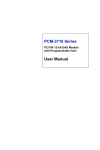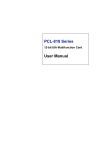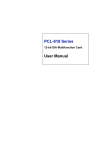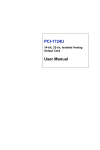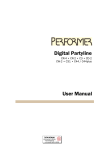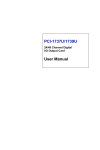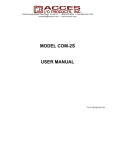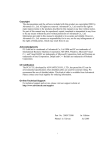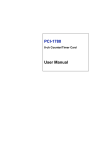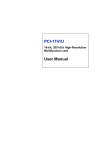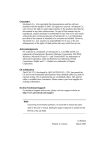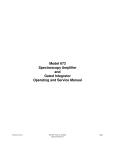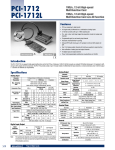Download PCM-3718H/3718HG PC/104 12
Transcript
PCM-3718H/3718HG PC/104 12-bit DAS Module with Programmable Gain User's manual 2nd Edition Printed in Taiwan May 1999 Contents CHAPTER 1: General Information ........................ 1 1.1 1.2 1.3 1.4 1.5 1.6 1.7 Introduction .......................................................................... 2 Features ................................................................................. 2 Specifications ......................................................................... 3 Locating Components ............................................................ 5 Daughterboards ..................................................................... 6 Software Support................................................................... 7 Block Diagram ....................................................................... 8 CHAPTER 2: Installation ........................................ 9 2.1 2.2 2.3 2.4 2.5 Initial Inspection ................................................................... 10 Switch and Jumper Settings .................................................. 10 Connector Pin Assignments .................................................. 13 Hardware Installation ........................................................... 15 Software Installation ............................................................. 16 CHAPTER 3: Signal Connections ........................ 17 3.1 Analog Input Signal Connections .......................................... 18 3.2 Expanding Analog Inputs ...................................................... 20 3.3 Digital Signal Connections .................................................... 20 CHAPTER 4: Register Structure and Format .... 23 4.1 4.2 4.3 4.4 4.5 A/D Data Registers - BASE+0/1.......................................... 25 Software A/D Trigger - BASE+0 ......................................... 25 A/D Range Control - BASE+1............................................. 26 MUX Scan Register -BASE+2 ............................................ 27 Digital I/O Registers - BASE+3/11 ....................................... 28 4.6 4.7 4.8 4.9 A/Dstatus Register - BASE+8 .............................................. 29 Control Register - BASE+9 ................................................. 31 Pacer Enable Register - BASE+10 ....................................... 32 Programmable Pacer Registers - BASE+12/13/14/15........... 33 CHAPTER 5: A/D Conversion .............................. 35 5.1 5.2 5.3 5.4 5.5 5.6 A/D Data Format and Status Register ................................... 36 Input Range Selection ........................................................... 37 MUX Setting ....................................................................... 37 Trigger Mode ....................................................................... 38 A/D Data Transfer ................................................................ 39 How to Make an A/D Conversion ........................................ 40 CHAPTER 6: Digital Input/Output....................... 41 CHAPTER 7: Programmable Pacer .................... 43 7.1 7.2 7.3 7.4 7.5 The Intel 8254 ..................................................................... 44 Counter Read/write and Control Register.............................. 45 Counter Operating Modes.................................................... 48 Counter Operations .............................................................. 50 Counter Applications............................................................ 51 CHAPTER 8: Direct Memory Access Operation 53 8.1 Using DMA Transfer with the PCM-3718H/3718HG ........... 54 CHAPTER 9: Calibration ...................................... 57 9.1 VR Assignment .................................................................... 58 9.2 A/D Calibration.................................................................... 58 CHAPTER 1 General Information 1.1 Introduction The PCM-3718H/3718HG is a high performance multifunction data acquisition module that attaches to the PC/104 connector on your CPU card or PC/104 module. It offers 12-bit A/D conversion and digital input/output. The automatic channel scanning circuitry and the on-board SRAM let you perform multiple-channel A/D conversion with DMA and individual channel gains. The PCM-3718H/3718HG is an advanced new version of our popular PCL-818 multifunction data acquisition card series. A custom 160pin ASIC chip integrates the functions of a full-size DAS card. This chip gives you maximum accuracy and reliability, along with minimum cost, size and power consumption. The resulting PC/104 module is fully software compatible with the PCL-818H/818HG. This puts rich software support and a wide variety of external signal conditioning boards at your disposal. The PCM-3718H/3718HG is excellent for data acquisition, process control, automatic testing and factory automation. 1.2 Features • 16 single-ended or 8 differential analog inputs, jumper selectable • 12-bit A/D converter, up to 100 kHz sampling rate with DMA transfer • Software programmable gain value for each analog input channel • Software selectable input range for each analog input channel • Two 8-bit digital input/output channels, TTL compatible • Flexible triggering options: software trigger, programmable pacer trigger and external pulse trigger • Data transfer by program control, interrupt handler routine or DMA • New-technology 160-pin 1.0µm CMOS ASIC chip 2 PCM-3718H/3718HG User's Manual 1.3 Specifications Analog Input: • Channels: 16 single-ended or 8 differential, jumper selectable • Resolution: 12 bits • Input range: (software programmable, VDC) PCM-3718H Bipolar: ±10, ±5, ±2.5, ±1.25, ±0.625 Unipolar: 0 ~ 10, 0 ~ 5, 0 ~ 2.5, 0 ~ 1.25 PCM-3718HG Bipolar: ±10, ±5, ±1, ±0.5, ±0.1, ±0.05, ±0.01, ±0.005 Unipolar: 0 ~ 10, 0 ~ 1, 0 ~ 0.1, 0 ~ 0.01 • Maximum data throughput PCM-3718H: 100 kHz PCM-3718HG: (variable, depending on PGIA settling time) Gain Speed 0.5, 1 100 kHz 5,10 35 kHz 50,100 7 kHz 500,1000 770 Hz • Accuracy: (depending on gain values) PCM-3718H Gain Accuracy 0.5,1 0.01% of FSR±1 LSB 2,4 0.02% of FSR±1 LSB 8 0.04% of FSR±1 LSB PCM-3718HG Gain Accuracy 0.5,1 0.01% of FSR±1 LSB 5,10 0.02% of FSR±1 LSB 50,100 0.04% of FSR±1 LSB for differential mode 500,1000 0.08% of FSR±1 LSB for differential mode Chapter 1 Gerneral Information 3 • • • • Differential nonlinearity error: ±1 LSB Input impedance: 1GΩ Trigger mode: Software, pacer or external trigger External trigger: TTL compatible Digital Input/ Output: • Channels: two 8-bit • Level: TTL compatible • Input voltage: Logic 0: 0.8 V max. Logic 1: 2.0 V min. • Output voltage: Logic 0: 0.33 V max. @ 6 mA (sink) Logic 1: 3.84 V min. @ 6 mA (source) Programmable pacer: • Device: Intel 8254 or equivalent • Counters: 3 channels, 16-bit. Counter 1 and Counter 2 are permanently configured as a 32-bit programmable pacer. Counter 0 is reserved for future development. • Time base: (for Counter 1’s clock input) 10 MHz or 1 MHz, jumper selectable. General: • Power consumption: +5VDC @ 180mA (Typical) +5VDC @ 400mA (Max.) • Digital I/O connector: 20-pin post headers for I/O connection. • Analog input connector: 20-pin post headers for I/O connection. • Operating temperature: 0 to +60°C (refer to IEC 68-2-1, 2) • Storage temperature: -20 to +70°C • Operating humidity: 5 to 95% non-condensing (refer to IEC 68-2-3) • MTBF: over 235,346 hrs @ 25°C, ground, fix environment 4 PCM-3718H/3718HG User's Manual 1.4 Locating Components JP 2 VR1 VR2 VR3 P1 P2 JP 1 SW 1 JP 3 J1 Connectors, switches and VR locations Label J1 JP1 JP2 JP3 P1 P2 SW1 VR1 VR2 VR3 Function PC-bus connector DMA level (1 or 3) and time base (1MHz or 10MHz) Differential or single-ended inputs DIO0 or external input Analog input Digital input/output connector Base address A/D full scale A/D bipolar offset A/D unipolar offset Chapter 1 Gerneral Information 5 1.5 Daughterboards We offer a wide variety of optional daughterboards to help you get the most from your PCM-3718H/3718HG. You will need the PCLD780/880 Screw-terminal Board or the PCLD-8115 Wiring Terminal Board to make connections. PCLD-789D Amplifier/Multiplexer Board This analog input-signal conditioning board multiplexes 16 differential inputs to one A/D input channel. A high-grade instrumentation amplifier provides switch selectable gains of 1, 2, 10, 50, 100, 200, 1000. PCLD-788 Relay Multiplexer Board This board multiplexes up to 16 differential inputs to one analog output channel. It offers isolated break-before-make high voltage switching and a CJC circuit for thermocouple measurement. PCLD-786 SSR I/O Module Carrier Board This board holds eight opto-isolated solid state relay modules and provides an additional eight outputs to drive external. PCLD-785B and PCLD-885 Relay Output Boards These boards let you control relays through the PCM-3718H/3718HG 16-bit digital output channels. The PCLD-785B provides 24 SPDT relays, while the PCLD-885 provides 16 SPDT power relays. PCLD-782B Isolated D/I Board This board provides 24 opto-isolated digital inputs for connecting to the PCM-3718H/3718HG digital input channels. PCLD-779 Relay-isolated Multiplexer and Amplifier Board This board lets you easily make multi-channel temperature measurements. We designed it for the cost-sensitive customer who requires precision, low-level signal measurement and isolation for industrial applications. 6 PCM-3718H/3718HG User's Manual 1.6 Software Support The PCM-3718H/3718HG comes with a powerful and easy-to-use software driver. This driver makes application programming much easier, especially when you use sophisticated features like interrupt or DMA data transfer. For building up a high performance Human Machine Interface (HMI), you may need other supporting software beside our included driver to the PCM-3718/3718HG. Please consult your manufacturer representative for appropriate software packages. GeniDAQ GeniDAQ is a Windows-based data acquisition, control, analysis and presentation development software package. In addition to typical Human Machine Interface (HMI) functions, GeniDAQ features a Visual Basic programming environment, and it provides numerous graphical control and display icons to assist you in developing user’s HMI. ActiveDAQ ActiveDAQ is a collection of add-on ActiveX Control which provides an easy-to-use property sheet interface for configuring analog/digital input/output, counter/frequency, high-speed data acquisition and controls. You can use ActiveX control in Visual Basic, Delphi, Visual C++ development environments for Windows 95/98/NT. LabVIEW Driver LabVIEW Driver supports National Instruments LabVIEW 4.1/5.0 and runs in Microsoft Windows 95/98 and Windows NT 4.0 environments. Chapter 1 Gerneral Information 7 1.7 Block Diagram PC BUS Addre ss B us Status D ata Buffer D M A S ignals IR Q Signals R egister Select ASIC A D1801 Addre ss D ecoder Internal D ata B us DMA Logic IR Q Logic EO C C LK 1 C LK 2 D ata M U X 1 MHz 10 M Hz C ounter #0 C ounter #1 C ounter #2 R AM 12-bit A/D C onverter w ith Sam ple and H old D ivider O ut 1 O ut 2 C hannel Scan Logic Prog. G ain Am plifie r 10 M H z O SC Trigger Logic Tw o 8-b it D igital In/O ut MUX 16 S/E or 8 D iff. D igital Input / O utput E xternal Trigger A nalog Input PCM-3718H/3718HG User's Manual 8 CHAPTER 2 Installation 2.1 Initial Inspection We carefully inspected the PCM-3718H/3718HG mechanically and electrically before we shipped it. It should be free of marks and scratches and in perfect order on receipt. As you unpack the PCM-3718H/3718HG, check it for signs of shipping damages (damaged box, scratches, dents, etc.). If it is damaged or fails to meet specifications, notify our service department or your local sales representative immediately. We will then make arrangement to repair or to replace the unit for you. Discharge any static electricity on your body before touching the board by touching the back of the system unit (grounded metal). Also keep from materials of static electricity such as plastic, vinyl and styrofoam. Remove the PCM-3718H/3718HG from its protective packaging by grasping the rear metal panel. Handle the module only by its edges to avoid static electricity which could damage its integrated circuits. Keep the anti-static packaging material for storage and protection when you have to remove the module from its connector. 2.2 Switch and Jumper Settings Ease-of-use is the primary design goal when we designed the PCM3718H/3718HG. This module has one function switch and seven jumper settings. The following sections tell you how to configure the module. You may want to refer to the figure on page 5 for details of module components. Base address selection (SW1) You control the PCM-3718H/3718HG’s operation by reading or writing data to the PC’s I/O (input/output) port addresses. The PCM3718H/3718HG requires 16 consecutive address locations. The switch SW1 sets the module’s base (beginning) address. Valid base 10 PCM-3718H/3718HG User's Manual addresses range from Hex 000 to Hex 3F0. Other devices in your system can use some of these addresses. We set the PCM-3718H/3718HG for a base address of Hex 300 at the factory. If you need to adjust it to other address ranges, set SW1 by referring to the following table: Module I/O addresses (SW1) Range (hex) Switch position 1 2 000 - 00F l l 010 - 01F l l : 200 - 20F ¡ l 210 - 21F ¡ l : *300 - 30F ¡ ¡ : 3F0 - 3FF ¡ ¡ ¡ = Off l = On * = default 3 l l 4 l l 5 l l 6 l ¡ l l l l l l l ¡ l l l l ¡ ¡ ¡ ¡ Note: Switches 1-6 of the SW1 control the PC bus address lines as follows: Switch Line 1 A9 2 A8 3 A7 4 A6 5 A5 6 A4 Chapter 2 Installation 11 DMA channel and timer clock selection (JP1) The PCM-3718H/3718HG supports DMA data transfer. The bottom pins of JP1 provide selection of DMA channel 1 or 3, as shown in the following figure. Channel 1 Channel 3 (default) 1M 1 0M 1M 1 0M DM1 DM3 DM1 DM3 The upper jumper of JP1 controls the input clock frequency for the 8254 programmable clock/timer of the module. You have two choices: 10MHz and 1MHz. This lets you generate pacer output frequencies from 2.5 MHz to 0.00023 Hz (71 minutes/pulse). The following equation gives the pacer rate: Pacer rate = Fclk / ( Div1 * Div2 ) (Fclk, 1MHz or 10MHz, is set by JP1 as illustrated above. Div1 and Div2 are dividers set in counter 1 and counter 2 in the Intel 8254 counter. See page 51 for more information on the counter/timer applications). 10 MHz 1 MHz (default) 1M 10M 1M 10M DM1 DM3 DM1 DM3 Channel configuration, S. E. or diff. (JP2) The PCM-3718H/3718HG offers 16 single-ended or eight differential analog input channels. Jumper JP2 sets the analog input channels as 16 single-ended or 8 differential inputs as below: 16 S.E. inputs S/E 12 DIFF Eight differential inputs (default) S/E PCM-3718H/3718HG User's Manual DIFF External input or DIO selection (JP3) You can use pin 1 on connector P2 for connection to digital I/O line 0 or to an external A/D trigger source jumper setting. Jumper JP3 provides the selection, as shown below: External trigger input DIO0 EXT Digital I/O line DIO 0 (default) DIO0 EXT 2.3 Connector Pin Assignments The PCM-3718H/3718HG has two on-board 20-pin flat-cable connectors (insulation displacement, mass termination). The figure on page 5 shows locations of both connectors. Refer to the table below for abbreviations of the pin assignment. Abbreviations A/D S A/D H A/D L A.GND DIO D.GND Description Analog input (single-ended) Analog input high (differential) Analog input low (differential) Analog ground Digital input/output Digital and power supply ground Chapter 2 Installation 13 Connector P1 - Analog input, single-ended operation A /D S 0 A /D S 1 A /D S 2 A /D S 3 A /D S 4 A /D S 5 A /D S 6 A /D S 7 A .G N D A .G N D 1 3 5 7 9 11 13 15 17 19 2 4 6 8 10 12 14 16 18 20 A /D S 8 A /D S 9 A /D S 1 0 A /D S 11 A /D S 1 2 A /D S 1 3 A /D S 1 4 A /D S 1 5 A .G N D A .G N D Connector P1 - Analog input, differential-ended operation A /D H 0 A /D H 1 A /D H 2 A /D H 3 A /D H 4 A /D H 5 A /D H 6 A /D H 7 A .G N D A .G N D 1 3 5 7 9 11 13 15 17 19 2 4 6 8 10 12 14 16 18 20 A /D L 0 A /D L 1 A /D L 2 A /D L 3 A /D L 4 A /D L 5 A /D L 6 A /D L 7 A .G N D A .G N D Connector P2 - Digital input /output D IO 0 D IO 2 D IO 4 D IO 6 D IO 8 D IO 1 0 D IO 1 2 D IO 1 4 D .G N D +5V 14 PCM-3718H/3718HG User's Manual 1 3 5 7 9 11 13 15 17 19 2 4 6 8 10 12 14 16 18 20 D IO 1 D IO 3 D IO 5 D IO 7 D IO 9 D IO 11 D IO 1 3 D IO 1 5 D .G N D + 1 2V 2.4 Hardware Installation Warning! TURN OFF your PC power supply whenever you install or remove the PCM-3718H/3718HG or connect and disconnect Cables. Installing the module 1. Turn off the PC’s power. Turn off the power of any peripheral devices such as printers and monitors. 2. Disconnect the power cord and any other cables from the back of the computer. 3. Remove the system unit cover (see the user’s guide of your chassis if necessary). 4. Remove the CPU card from the chassis (if necessary) to gain access to the card’s PC/104 connector. 5. Connect the connector J1 of the PCM-3718H/3718HG to the PC/ 104 connector. Carefully align the pins to the PC/104 connector. Slide the module into the connector. The module pins may not slide all the way into the connector; do not force the pins into place, or the module may be damaged. 6. Fasten the module to the CPU card by using the included brass screw. Screw the brass spacer into the threaded hole on the CPU card. Do not tighten too much, or the threads may be damaged. 7. Attach any accessories to the PCM-3718H/3718HG using 20 pin cables. 8. Reinstall the CPU card and replace the system unit cover. Reconnect the cables you removed in step 2. Plug in and turn on the power. This completes the hardware installation. Install the software driver as described in the following section. Chapter 2 Installation 15 2.5 Software Installation The PCM-3718H/3718HG includes a CD-ROM with utility software. The CD-ROM contains: 1. A comprehensive I/O driver for A/D and digital I/O applications. This driver lets you use standard functions, written in common programming languages, to operate the PCM-3718H/3718HG. You do not need to perform detailed register programming. The driver supports the following languages: Microsoft Visual Basic, Visual C++, Borland C++, C++ Builder and Delphi. Please refer to the Software Driver User’s Manual for more information. 2. Demonstration programs 3. A calibration program 4. A test program 16 PCM-3718H/3718HG User's Manual CHAPTER 3 Signal Connections Correct signal connections ensure that your application sends and receives data accurately. Good signal connections can also avoid a lot of unnecessary damage to the PC and other hardware. This chapter provides information on signal connections for different types of data acquisition applications. 3.1 Analog Input Signal Connections The PCM-3718H/3718HG supports either 16 single-ended or eight differential analog inputs. Jumper JP2 selects the input channel configuration. The major difference between single-ended and differential input connections is the number of signal wires per input channel. Single-ended channel connections Single-ended connections use only one signal wire per channel. The voltage on the line refers to the common ground on the card. A signal sources without a local ground is called a “floating” source. It is fairly simple to connect a signal-ended channel to a floating signal source. A standard wiring diagram looks like this: Signal Input + Vs - To A/D A.GND A.GND Differential channel connection The differential input configuration uses two signal wires per channel. The card measures the voltage difference between these two wires, the HIGH wire and the LOW wire. If the signal source has no connection to local ground, it is called a “floating’ source. A connection must exist between LOW and ground to define a common reference point for floating signal sources. To measure a floating source connect the input channel as shown below: 18 PCM-3718H/3718HG User's Manual HIGH + + Vs - LOW + Vin - A.GND If the signal source has one side connected to a local ground, the signal source ground and the PCM-3718H/3718HG ground will not be at exactly the same voltage, as they are connected through the ground return of the equipment and building wiring. The difference between the ground voltages forms a common-mode voltage. To avoid the ground loop noise effect caused by common-mode voltages, connect the signal ground to the LOW input. Do not connect the LOW input to the PCM-3718H/3718HG ground directly. In some cases you may also need a wire connection between the PCM-3718H/3718HG ground and the signal source ground for better grounding. The following two diagrams show correct and incorrect connections for a differential input with local ground: Correct connection HIGH + + Vs - LOW _ + Vin - Vin=Vs - GND + Vcm Incorrect connection HIGH + + Vs _ + Vcm LOW + Vin - Vin=Vs+Vcm - GND Chapter 3 Signal Connections 19 3.2 Expanding Analog Inputs You can expand any or all of the PCM-3718H/3718HG’s A/D input channels by using the multiplexing daughterboards. Most daughterboards are connected directly to the module’s 20-pin connectors. You may require the PCLD-8115 Screw-terminal Board for connections. The PCLD-789 Amplifier and Multiplexer multiplexes 16 differential inputs to one A/D input channel. You can cascade up to eight PCLD789s to the PCM-3718H/3718HG for a total of 128 channels. The PCLD-8115 Screw-terminal Board makes wiring connections easy. It provides 20-pin flat cable connectors and a CJC (Cold Junction Compensation) circuit which lets you directly measure thermocouples. You can handle all types of thermocouples with software compensation and linearization. Special circuit pads on the PCLD-8115 accommodate passive signal contioning components. You can easily implement a low-pass filter, attenuator or current shunt by adding resisters and capacitors. 3.3 Digital Signal Connections The PCM-3718H/3718HG has two 8-bit digital input/output channels. The digital I/O levels are TTL compatible. The following figure shows connections of digital signals with other TTL devices: TTL D evices D IO or D .G N D 20 PCM-3718H/3718HG User's Manual D .G N D To receive an OPEN/SHORT signal from a switch or relay, add a pullup resistor to ensure that the input is held at a high level when the contacts are open. See the figure below: +5V 4.7K D.GND Chapter 3 Signal Connections 21 22 PCM-3718H/3718HG User's Manual CHAPTER 4 Register Structure and Format The key to programming the PCM-3718H/3718HG is to understand the function of the card’s 16 registers. The PCM-3718H/3718HG requires 16 consecutive addresses in the PC’s I/O space. Each address corresponds to a card register. The address of each register is specified as an offset from the card’s base address. For example, BASE+0 is the card’s base address and BASE+7 is the base address plus seven bytes. If the card’s base address is 300h, the register’s address is 307h. The following sections give detailed information on the layout and function of each of the card’s registers. I/O port address map The following table shows the function of each register or driver and its address relative to the base address of the module. I/O port address assignments Address Read BASE+0 A/D low byte & channel BASE+1 A/D high byte BASE+2 MUX scan BASE+3 BASE+4 BASE+5 BASE+6 BASE+7 BASE+8 BASE+9 BASE+10 BASE+11 BASE+12 BASE+13 BASE+14 BASE+15 24 Write Software A/D trigger A/D range control MUX scan channel & range control pointer DIO low byte (DIO 0-7) DIO low byte (DIO 0-7) N/A N/A N/A N/A N/A N/A N/A N/A Status Clear interrupt request Control Control N/A Counter enable DIO high byte (DIO 8-15) DIO high byte (DIO 8-15) Counter 0 Counter 0 Counter 1 Counter 1 Counter 2 Counter 2 N/A Counter control PCM-3718H/3718HG User's Manual 4.1 A/D Data Registers - BASE+0/1 Two read-only registers at BASE+0 and BASE+1 hold A/D conversion data. The 12 bits of data from the A/D conversion are stored in BASE+1 bit 7 to bit 0 and BASE+0 bit 7 to bit 4. BASE+0 bits 3 to 0 store the source A/D channel number. BASE+0 (read only) - A/D low byte & channel number Bit D7 D6 D5 D4 D3 D2 D1 Value AD3 AD2 AD1 AD0 C3 C2 C1 D0 C0 BASE+1 (read only) - A/D high byte Bit D7 D6 D5 D4 D3 Value AD11 AD10 AD9 AD8 AD7 D0 AD4 D2 AD6 D1 AD5 AD11 to AD0 Analog to digital data. AD0 is the least significant bit (LSB) of the A/D data, and AD11 is the most significant bit (MSB) C3 to C0 A/D channel number from which the data is derived. C3 is the MSB and C0 is the LSB 4.2 Software A/D Trigger - BASE+0 You can trigger an A/D conversion from software, the module’s onboard pacer or from an external pulse. Bits 1 and 0 of register BASE+9 (shown on pages 31~32) select the trigger source. If you select software triggering, a write to the register BASE+0 with any value will trigger an A/D conversion. Chapter 4 Register Structure and Format 25 4.3 A/D Range Control - BASE+1 Each A/D channel has its own individual input range, controlled by a range code stored in the on-board RAM. If you want to change the range code for a given channel, select the channel as the start channel in register BASE+2, MUX scan (described in the next section), then write the range code to bits 0 to 3 of BASE+1. BASE+1 (write only) - A/D range control code Bit D7 D6 D5 D4 D3 D2 Value N/A N/A N/A N/A G3 G2 D1 G1 D0 G0 PCM-3718H range code: Input Range(V) Unipolar/Bipolar ±5 ±2.5 ±1.25 ±0.625 0 to 10 0 to 5 0 to 2.5 0 to 1.25 ±10 N/A N/A N/A N/A N/A N/A N/A 26 B B B B U U U U B PCM-3718H/3718HG User's Manual G3 0 0 0 0 0 0 0 0 1 1 1 1 1 1 1 1 Range Code G2 G1 0 0 0 0 0 1 0 1 1 0 1 0 1 1 1 1 0 0 0 0 0 1 0 1 1 0 1 0 1 1 1 1 G0 0 1 0 1 0 1 0 1 0 1 0 1 0 1 0 1 PCM-3718HG range code: Input Range(V) Unipolar/Bipolar ±5 ±0.5 ±0.05 ±0.005 0 to 10 0 to 1 0 to 0.1 0 to 0.01 ±10 ±1 ±0.1 ±0.01 N/A N/A N/A N/A B B B B U U U U B B B B G3 0 0 0 0 0 0 0 0 1 1 1 1 1 1 1 1 Range Code G2 G1 0 0 0 0 0 1 0 1 1 0 1 0 1 1 1 1 0 0 0 0 0 1 0 1 1 0 1 0 1 1 1 1 G0 0 1 0 1 0 1 0 1 0 1 0 1 0 1 0 1 4.4 MUX Scan Register -BASE+2 Read/write register BASE+2 controls multiplexer (MUX) scanning. The high nibble provides the stop scan channel number, and the low nibble provides the start scan channel number. The MUX initializes automatically to the start channel when you write to this register. Each A/D trigger sets the MUX to the next channel. With continuous triggering, the MUX will scan from the start channel to the end channel, and then repeat the process. For example, if the start channel is 3 and the stop channel is 7, then the scan sequence is 3, 4, 5, 6, 7, 3, 4, 5, 6, 7, 3, 4 ... Chapter 4 Register Structure and Format 27 BASE+2 (write) - start and stop scan channels Bit D7 D6 D5 D4 D3 D2 Value CH3 CH2 CH1 CH0 CL3 CL2 CH3 to CH0 Stop scan channel number CL3 to CL0 Start scan channel number D1 CL1 D0 CL0 The MUX scan register low nibble, CL3 to CL0, also acts as a pointer when you program the A/D input range (see previous section). When you set the MUX start channel to N, the range code written to the register BASE+1 is for channel N. Programming example This C code sets the range for channel 5 to ±0.625 V: OUTPORTB (BASE+2, 5); /* SET POINTER TO CHANNEL 5*/ OUTPORTB (BASE+1, 3); /* RANGE CODE FOR ±0.625V*/ Note: The MUX start/stop channel changes each time when you change the input range. Do not forget to reset the MUX start and stop channels to the correct values after your range setting. 4.5 Digital I/O Registers - BASE+3/11 The PCM-3718H/3718HG offers two 8-bit digital input/output channels. These I/O channels use the input or output ports at addresses Base+3 and BASE+11. 28 PCM-3718H/3718HG User's Manual BASE+3 (read port) -DIO low byte Bit D7 D6 D5 D4 D3 D2 D1 D0 Value DIO7 DIO6 DIO5 DIO4 DIO3 DIO2 DIO1 DIO0 BASE+3 (write port) DIO low byte Bit D7 D6 D5 D4 D3 D2 D1 D0 Value DIO7 DIO6 DIO5 DIO4 DIO3 DIO2 DIO1 DIO0 BASE+11 (read port) - DIO high byte Bit D7 D6 D5 D4 D3 D2 D1 D0 Value DIO15 DIO14 DIO13 DIO12 DIO11 DIO10 DIO9 DIO8 BASE+11 (write port) - DIO high byte Bit D7 D6 D5 D4 D3 D2 D1 D0 Value DIO15 DIO14 DIO13 DIO12 DIO11 DIO10 DIO9 DIO8 4.6 A/D Status Register - BASE+8 Read-only register BASE+8 provides information on the A/D configuration and operation. Writing to this I/O port with any data value clears its INT bit. The other data bits do not change. BASE+8 - A/D status Bit D7 D6 D5 D4 Value EOC N/A MUX INT D3 CN3 D2 CN2 D1 CN1 D0 CN0 Chapter 4 Register Structure and Format 29 EOC MUX INT End of Conversion. 0 The A/D converter is idle, ready for the next conversion. Data from the previous conversion is available in the A/D data registers. 1 The A/D converter is busy, implying that the A/D conversion is in progress. Single-ended/differential channel indicator. 0 8 differential channels 1 16 single-ended channels Data valid. 0 No A/D conversion has been completed since the last time the INT bit was cleared. Values in the A/D data registers are not valid data. 1 The A/D conversion is completed, and converted data is ready. If the INTE bit of the control register (BASE+9) is set, an interrupt signal will be sent to the PC bus through interrupt level IRQn, where n is specified by bits I2, I1 and I0 of the control register. Though the A/D status register is read-only, writing to it with any value clears the INT bit. CN3 to CN0 When EOC = 0, these status bits contain the channel number of the next channel to be converted. Remarks If you trigger the A/D conversion by the on-board pacer, your software should check the INT bit, not the EOC bit, before it reads the conversion data. EOC can equal 0 in two different situations: the conversion is completed or no conversion has been started. Your software should therefore wait for the signal INT = 1 before it reads the conversion data. It should then clear the INT bit by writing any value to the A/D status register BASE+8. 30 PCM-3718H/3718HG User's Manual 4.7 Control Register - BASE+9 Read/write register BASE+9 provides information on the PCM-3718’s operating modes. BASE+9 - Control Bit D7 D6 Value INTE I2 D5 I1 D4 I0 D3 X D2 D1 DMAE ST1 D0 ST0 INTE Disable/enable PCM-3718H/3718HG interrupt generation 0 Disables the generation of interrupts. No interrupt signal will be sent to the PC bus. 1 Enables the generation of interrupts. If DMAE = 0, the PCM-3718H/3718HG will generate an interrupt when it completes an A/D conversion. Use this setting for interrupt driven data transfer. If DMAE = 1, the PCM-3718H/3718HG will generate an interrupt when it receives a T/C (terminal count) signal from the PC’s DMA controller, indicating that a DMA transfer has been completed. Use this setting for DMA data transfer. The DMA transfer is stopped by the interrupt caused by the T/C signal. See DMAE below. I2 to I0 Interrupt level N/A N/A IRQ2 IRQ3 IRQ4 IRQ5 IRQ6 IRQ7 Selects the interrupt level. INL2 0 0 0 0 1 1 1 1 INL1 0 0 1 1 0 0 1 1 INL0 0 1 0 1 0 1 0 1 Chapter 4 Register Structure and Format 31 Note: Make sure that the IRQ level you choose is not being used by another I/O device. DMAE Disable/Enable PCM-3718H/3718HG DMA transfers. 0 Disables DMA transfer. 1 Enables DMA transfer. Each A/D conversion initiates two successive DMA request signals. These signals cause the 8237 DMA controller to transfer two bytes of conversion data from the PCM-3718H/3718HG to memory. Note: You must program the PC’s 8237 DMA controller as the DMA page register before you set DMAE to1. ST1 to ST0 Trigger source Software trigger External trigger Pacer trigger Trigger source ST1 0 1 1 ST0 X 0 1 4.8 Pacer Enable Register - BASE+10 Register BASE+10 enables or disables the PCM-3718H/3718HG pacer. TC0 32 Disalbe/enable pacer 0 Pacer enabled 1 Pacer disabled PCM-3718H/3718HG User's Manual 4.9 Programmable Pacer Registers BASE+12/13/14/15 These four registers located at addresses BASE+12, BASE+13, BASE+14 and BASE+15 are used for the Intel 8254 programmable pacer. Please refer to Chapter 7 Programmable Pacer or 8254 product literature for detailed application information. Chapter 4 Register Structure and Format 33 34 PCM-3718H/3718HG User's Manual CHAPTER 5 A/D Conversion This chapter explains how to use the PCM-3718H/3718HG’s A/D conversion functions. The first five sections describe A/D data format, input range selection, status register settings, MUX scan setting, trigger modes and data transfer. The last section gives step by step implementation guidelines for A/D operations. 5.1 A/D Data Format and Status Register Since the PCM-3718H/3718HG uses 12-bit A/D conversions, a single 8-bit register will not accommodate all the data. The PCM-3718H/ 3718HG therefore stores A/D data in two registers located at addresses BASE+0 and BASE+1. It stores the A/D low byte data in bits D4 to D7 (AD0 to AD3) of BASE+0 and high byte data in bits D0 to D7 (AD4 to AD11) of BASE+1. The least significant bit is AD0 and the most significant bit is AD11. You can read the source channel number corresponding to the A/D data from bits D0 to D3 (C0 to C3) of BASE+0. A/D data register format is: BASE+0 (read only) - A/D low byte & channel number Bit D7 D6 D5 D4 D3 D2 D1 Value AD3 AD2 AD1 AD0 C3 C2 C1 D0 C0 BASE+1 (read only) - A/D high byte Bit D7 D6 D5 D4 D3 Value AD11 AD10 AD9 AD8 AD7 D0 AD4 D2 AD6 D1 AD5 The A/D status register at BASE+8 (read only) gives information on A/D configuration and operation. 36 PCM-3718H/3718HG User's Manual A/D status register format is: BASE+8 - A/D status Bit D7 D6 D5 D4 Value EOC N/A MUX INT D3 CN3 D2 CN2 D1 CN1 D0 CN0 Bits in this register indicate the end of conversion status, singleended/differential input, interrupt status and the number of the channel to be converted next. Refer to page 29, A/D Status Register, for more information. 5.2 Input Range Selection Each A/D channel has its own individual input range, controlled by a range code stored in the on-board RAM. Please refer to pages 26~27, A/D Range Control, for more information. 5.3 MUX Setting The PCM-3718H/3718HG offers 16 single-ended or eight differential analog input channels. Set jumper JP2 for the channel configuration before you set the multiplexer scan range. The MUX scan register specifies the high and low limits of the scan range. The MUX scan register is a read/write register at address BASE+2. Bits D0 to D3 hold the starting channel number, and positions D4 to D7 hold the stop scan channel number. When you set the PCM-3718H/3718HG for eight differential input channels, set bits CH3 and CL3 to zero. Chapter 5 A/D Conversion 37 The MUX scan register data format is as below: BASE+2 (write) - start and stop scan channels Bit D7 D6 D5 D4 D3 D2 Value CH3 CH2 CH1 CH0 CL3 CL2 D1 CL1 D0 CL0 If you require only one A/D input channel, you should set the high and low scan limits to the same value. If you specify a range of input channels, the PCM-3718H/3718HG automatically performs an A/D conversion on each channel in the range, beginning with the start channel. When it reaches the stop channel, it loops back to the start channel and continues. This looping continues until the specified number of conversions is completed. Note that writing to the MUX automatically resets to the start channel. You can specify channel settings by writing directly to the MUX scan register. Use the MUX scan register to assign to a specified channel when you set channel input ranges (with BASE+1). After you set the input range, you will need to reset the MUX register for the proper start and stop channels. 5.4 Trigger Mode You can trigger an A/D conversion from software, from the module’s on-board pacer or from an external signal. Bits 1 and 0 of register BASE+9 select the trigger source. 1. If you select software triggering, write to register BASE+0 with any value to trigger an A/D conversion. High-speed A/D applications do not normally use software triggering because the triggering rate is too slow. 2. The PCM-3718H/3718HG’s on-board Intel 8254 programmable interval timer/counter can generate periodic timing signals. Counters 1 and 2 of the Intel 8254 provide A/D converter trigger pulses with precise periods. You can select pacer output between 38 PCM-3718H/3718HG User's Manual 2.5 MHz and 71 minutes per pulse. Chapter 7 cover the details of the Intel 8254 timer/counter. Pacer triggering is ideal for interrupt and DMA data transfer, normally used in A/D applications which require higher conversion speeds. 3. You can also trigger the A/D conversion from an external signal. Wire the external signal to pin 1 on connector P2 and switch jumper JP3 to EXT. You would normally use external triggering if your application requires A/D conversions not periodically, but conditionally, e. g., to measure a voltage when a limit switch closes. The A/D conversion starts at the rising edge of the external trigger pulse. 5.5 A/D Data Transfer You can perform A/D data transfer by Program Control, Interrupt Routine or DMA. 1. Program controlled data transfer operates by polling the A/D status register. After the A/D conversion has been triggered, your application program checks the INT bit (data valid) of the A/D status register. When it detects that the INT bit is on (1), it sends the A/D data to the PC’s memory using DMA. Reset the INT bit (by writing to register BASE+8 with any value) after you transfer the A/D data. When you use software triggering, you can check either the INT or EOC bits for data validity. Since you use the program to trigger the A/D conversion, you do not need to poll the INT bit to see if the conversion has occurred. It is easier to use the EOC bit, because you do not need to clear it after you transfer the data. 2. With interrupt data transfer, you write an interrupt routine handler program, which transfers data from the module’s A/D data registers to a previously defined memory segment in the PC. At the end of each conversion, the EOC signal generates an interrupt, and the interrupt handler routine performs the transfer. You must specify the interrupt control bit and the interrupt level selection bits in the PCM-3718H/3718HG control register (BASE+9) before using the Chapter 5 A/D Conversion 39 interrupt routine. Writing to the A/D status register address (BASE+8) resets the PCM-3718H/3718HG interrupt request and reenables the PCM-3718H/3718HG interrupt. 3. Direct Memory Access (DMA) Transfer moves the A/D data from the PCM-3718H/3718HG hardware device to the PC system memory without the system CPU. DMA is very useful in high-speed data transfer, but it is complicated to operate. Before the DMA operation you must set the DMA level (JP1), the DMA enable bit control register (BASE+9) and the registers in the 8237 DMA controller. We recommend that you use the PCM-3718H/3718HG driver to perform DMA operations. See Chapter 8 for more Information on the 8237 DMA controller and PCM-3718H/3718HG DMA operations. 5.6 How to Make an A/D Conversion To perform A/D conversion, you can write all I/O port instructions directly in your program, or you can take advantage of the PCM3718H/3718HG driver. We suggest that you apply the driver functions in your program. This will make your programming job easier and improve the program performance. See the User’s Manual of the software driver for more information. Do the following to perform software trigger and program controlled data transfer without the PCM-3718H/3718HG driver: 1. Set the input range for each A/D channel. 2. Set the input channel by specifying the MUX scan range. 3. Trigger the A/D conversion by writing to the A/D low byte register (BASE+0) with any value. 4. Check for the end of the conversion by reading the A/D status register (BASE+8) INT bit. 5. Read data from the A/D converter by reading the A/D data registers (BASE+0 and BASE+1). 6. Convert the binary A/D data to an integer. 40 PCM-3718H/3718HG User's Manual CHAPTER 6 Digital Input/Output The PCM-3718H/3718HG provides two 8-bit digital input/output channels. The registers at addresses BASE+3 and BASE+11 can input or latch output data. Data format for each register appears as below: BASE+3 (read port) -DIO low byte Bit D7 D6 D5 D4 D3 D2 D1 D0 Value DIO7 DIO6 DIO5 DIO4 DIO3 DIO2 DIO1 DIO0 BASE+3 (write port) DIO low byte Bit D7 D6 D5 D4 D3 D2 D1 D0 Value DIO7 DIO6 DIO5 DIO4 DIO3 DIO2 DIO1 DIO0 BASE+11 (read port) - DIO high byte Bit D7 D6 D5 D4 D3 D2 D1 D0 Value DIO15 DIO14 DIO13 DIO12 DIO11 DIO10 DIO9 DIO8 BASE+11 (wirte port) - DIO high byte Bit D7 D6 D5 D4 D3 D2 D1 D0 Value DIO15 DIO14 DIO13 DIO12 DIO11 DIO10 DIO9 DIO8 Using the PCM-3718H/3718HG’s input and output functions is fairly straightforward. Page 20 shows some ideas for digital signal connections. 42 PCM-3718H/3718HG User's Manual CHAPTER 7 Programmable Pacer 7.1 The Intel 8254 The PCM-3718H/3718HG uses the Intel 8254 programmable interval timer/counter version 2. The popular 8254 offers three independent 16-bit down counters. Each counter has a clock input, control gate and an output. You can program each counter for maximum count values from 2 to 65535. Version 2 of the 8254 has a maximum input clock frequency of 10 MHz. The PCM-3718H/3718HG provides 1 MHz and 10 MHz input frequencies to the 8254 from an on-board crystal oscillator. Jumper JP1 controls the input frequency. See page 12 for more information. Counters 1 and 2 on the 8254 are cascaded and operated in a fixed divider configuration. Counter 1 input is connected to the 1 MHz or 10 MHz clock frequency, and the output of Counter 1 is connected to the input of Counter 2. The output of Counter 2 is internally configured to provide trigger pulses to the A/D converter, as shown below: COUNTER 1 1MHZ OR 10MHZ OSC. CLK IN OUT COUNTER 2 CLK IN OUT PACER The Intel 8254 has six operational modes, from Mode 0 through Mode 5. To generate a pacer clock, program both Counter 1 and Counter 2 for Mode 3 (square wave generation). Note!: Counter 0 is reserved for future development. 44 PCM-3718H/3718HG User's Manual 7.2 Counter Read/write and Control Register The 8254 programmable interval timer uses four registers at addresses BASE+12, BASE+13, BASE+14 and BASE+15. Register functions are listed below: Register BASE+12 BASE+13 BASE+14 BASE+15 Function Counter 0 read/write Counter 1 read/write Counter 2 read/write Counter control word Since the 8254 counter uses a 16-bit structure, each section of read/ write data is split into a least significant byte (LSB) and most significant byte (MSB). To avoid errors it is important that you make read/write operations in pairs and keep track of the byte order. The data format for the control register appears below: BASE+15 - 8254 control, standard mode Bit D7 D6 D5 D4 D3 Value SC1 SC0 RW1 RW0 M2 SC1 & SC0 D2 M1 D1 M0 D0 BCD Select counter Counter 0 1 2 Read-back command SC1 0 0 1 1 SC0 0 1 0 1 Chapter 7 Programmable Pacer 45 RW1 & RW0 Select read/write operation Operation Counter latch Read/write LSB Read/write MSB Read/write LSB first, then MSB RW1 0 0 1 1 RW0 0 1 0 1 M2, M1 & M0 Select operating mode M2 0 0 X X 1 1 BCD BCD 0 1 M1 0 0 1 1 0 0 M0 0 1 0 1 0 1 Mode 0 1 2 3 4 5 Description programmable one shot programmable one shot Rate generator Square wave rate generator Software triggered strobe Hardware triggered strobe Select binary or BCD counting Type Binary counting 16-bits Binary coded decimal (BCD) counting If you set the module for binary counting, the count can be any number from 0 up to 65535. If you set it for BCD (Binary Coded Decimal) counting, the count can be any number from 0 to 9999. If you set both SC1 and SC0 bits to 1, the counter control register is in read-back command mode. The control register data format becomes: BASE+15 - 8254 control, read-back mode Bit D7 D6 D5 D4 D3 Value 1 1 CNT STA C2 46 PCM-3718H/3718HG User's Manual D2 C1 D1 C0 D0 X CNT = 0 Latch count of selected counter(s). STA = 0 Latch status of selected counter(s). C2, C1 & C0 Select counter for a read-back operation. C2 = 1 select Counter 2 C1 = 1 select Counter 1 C0 = 1 select Counter 0 If you set both SC1 and SC0 to 1 and STA to 0, the register selected by C2 to C0 contains a byte which shows the status of the counter. The data format of the counter read/write register then becomes: BASE+12/13/14 - status read-back mode Bit D7 D6 D5 D4 D3 Value OUT NC RW1 RW0 M2 D2 M1 D1 M0 D0 BCD OUT Current status of counter output NC Null count is 1 when the last count written to the counter register has been loaded into the counting element The pacer enable register, located at address BASE+10, has a close relationship with the counter operation. Refer to pages 32~33, Pacer Enable Register, for the register data format. The TC0 bit enables and disables the pacer. If TC0 is 0, the pacer is enabled. If TC0 is 1, the pacer is disabled. Chapter 7 Programmable Pacer 47 7.3 Counter Operating Modes MODE 0 - Stop on Terminal Count The output will be initially low when you set mode 0. After you load the count into the selected count register, the output will remain low and the counter will count. When the counter reaches the terminal count, its output will go high and remain high until you reload it with the mode or a new count value. The counter continues to decrement after it reaches the terminal count. Rewriting a counter register during counting has the following results: 1. Writing to the first byte stops the current counting. 2. Writing to the second byte starts the new count. MODE 1 - Programmable One-shot The output is initially high. The output will go low on the count following the rising edge of the gate input. It will then go high on the terminal count. If you load a new count value while the output is low, the new value will not affect the duration of the one-shot pulse until the succeeding trigger. You can read the current count at any time without affecting the one-shot pulse. The one-shot is retriggerable, thus the output will remain low for the full count after any rising edge at the gate input. MODE 2 - Rate Generator The output will be low for one period of the input clock. The period from one output pulse to the next equals the number of input counts in the counter register. If you reload the counter register between output pulses, the present period will not be affected, but the subsequent period will reflect the value. The gate input, when low, will force the output high. When the gate input goes to high, the counter will start from the initial count. You can thus use the gate input to synchronize the counter. With this mode the output will remain high until you load the count register. You can also synchronize the output by software. 48 PCM-3718H/3718HG User's Manual MODE 3 - Square Wave Generator This mode is similar to Mode 2, except that the output will remain high until one half of the count has been completed (for even numbers), and will go low for the other half of the count. This is accomplished by decreasing the counter by two on the falling edge of each clock pulse. When the counter reaches the terminal count, the state of the output is changed, the counter is reloaded with the full count and the whole process is repeated. If the count is odd and the output is high, the first clock pulse (after the count is loaded) decrements the count by 1. Subsequent clock pulses decrement the count by 2. After timeout, the output goes low and the full count is reloaded. The first clock pulse (following the reload) decrements the counter by 3. Subsequent clock pulses decrement the count by two until timeout, then the whole process is repeated. In this way, if the count is odd, the output will be high for (N+1)/2 counts and low for (N-1)/2 counts. MODE 4 - Software triggered strobe After the mode is set, the output will be high. When the count is loaded, the counter will begin counting. On terminal count, the output will go low for one input clock period, then go high again. If you reload the count register during counting, the new count will be loaded on the next CLK pulse. The count will be inhibited while the GATE input is low. MODE 5 - Hardware Triggered Strobe The counter will start counting after the rising edge of the trigger input and will go low for one clock period when the terminal count is reached. The counter is retriggerable. Chapter 7 Programmable Pacer 49 7.4 Counter Operations Read/Write Operation Before you write the initial count to each counter, you must first specify the read/write operation type, operating mode and counter type in the control byte and write the control byte to the control register (BASE+15). Since the control byte register and all three counter read/write registers have separate addresses, and each control byte specifies the counter it applies to (set by SC1 and SC0), no instructions on the operating sequence are required. Any programming sequence following the 8254 convention is acceptable. There are three types of counter operation: read/load LSB, read/load MSB and read/load LSB followed by MSB. It is important that you make your read/write operations in pairs and keep track of the byte order. Counter Read-back Command The 8254 counter read-back command lets you check the count value, programmed mode and current states of the OUT pin and Null Count flag of the selected counter(s). You write this command to the control word register. Format is as shown at the beginning of the chapter. The read-back command can latch multiple counter output latches. Simply set the CNT bit to 0 and select the desired counter(s). This single command is functionally equivalent to multiple counter latch commands, one for each counter latched. The read-back command can also latch status information for selected counter(s) by setting the STA bit to 0. The status must be latched to be read; the status of a counter is accessed by a read from that counter. For the counter status format please see the beginning of the chapter. Counter Latch Operation Users often want to read the value of a counter without disturbing the count in progress. You can enable this function by latching the count value for the specific counter and then reading the value. 50 PCM-3718H/3718HG User's Manual The 8254 supports the counter latch operation in two ways. The first way is to set bits RW1 and RW0 to 0. This setting latches the count of the selected counter in a 16-bit hold register. The second way is to perform a latch operation under the read-back command. Set bits SC1 and SC0 to 1 and CNT to 0. The latter method has the advantage of operating several counters at the same time. A subsequent read operation on the selected counter will retrieve the latched value. 7.5 Counter Applications The 8254 programmable Interval timer/counter on your PCM-3718H/ 3718HG interface module is a very useful device. You can program counters 1 and 2 as pacers to generate A/D conversion trigger pulses. Counter 0 is reserved for later module development. Setting the Pacer Rate The following equation gives the pacer rate: Pacer rate = FCLK / (C1 *C2) FCLK is either 1 MHz or 10 MHz, as set by jumper JP1. The following steps tell you how to set the counter modes and constants: 1. Set Counter 1 to Mode 3 by writing ’76h’ to address BASE+15. 2. Set Counter 2’s divisor constant C1 by writing to BASE+13. Constant C1 can be any 16-bit value from 2 to 65535. Because the 8254 has 8-bit registers, you should first write the low byte of C1 to BASE+13, then write the high byte of C1 to BASE+13. 3. Set Counter 2 to Mode 3 by writing ‘B6h’ to address BASE+15. 4. Set Counter 2’s divisor constant C2 by writing to BASE+14. Constant C2 can be any 16-bit value from 2 to 65535. Because the 8254 has 8-bit registers, you should first write the low byte of C2 to BASE+14, then write the high byte of C2 to BASE+14. Chapter 7 Programmable Pacer 51 Programming example The following program (written in C) sets the pacer rate to 25 KHz. It uses FCLK of 10 MHz, C1 of 40 and C2 of 10.25KHz = 19 MHz/ (40*10). OUTPORTB (BASE+3, 0x76); /* SET COUNTER 1 TO MODE 3*/ OUTPORTB (BASE+1, 40); /* WRITE LOW BYTE OF C1*/ OUTPORTB (BASE+1, 0); /* WRITE HIGH BYTE OF C1*/ OUTPORTB (BASE+3, 0xB6); /* SET COUNTER 2 TO MODE 3*/ OUTPORTB (BASE+2, 10); /*WRITE LOW BYTE OF C2*/ OUTPORTB (BASE+2, 0); /*WRITE HIGH BYTE OF C2*/ 52 PCM-3718H/3718HG User's Manual CHAPTER 8 Direct Memory Access Operation Direct Memory Access (DMA) improves system performance by allowing external devices to transfer information directly to or from the PC’s memory without using the CPU. The PCM-3718H/3718HG’s DMA capability significantly improves the system performance in high-speed A/D applications. Introduction to the 8237 DMA Controller The 8237 DMA controller chip on the PC system board handles the DMA operation. This chip has four prioritized direct memory access channels. Channel 0 is reserved by the PC system to refresh its dynamic RAM. Channel 2 supports floppy disk operations. Channel 3 is generally used for hard disk operations. Channel 1 is not for any internal operations and is reserved for your applications. Each channel has two associated control signals. The DMA Request Signal (DRQ) triggers a DMA operation, and the DMA Acknowledge Signal (DACK) authorizes the 8237 to start the data transfer. The 8237 DMA chip has four operating modes (single, demand, block and cascade) and four control registers. These registers are: 1. Operation mode register (set mode of operation) 2. Address register (specify memory segment starting address) 3. Word count register (specify the number of transfers) 4. Initialization register (enable and disable DMA channels) You must properly set all four registers before requesting the DMA operation. 8.1 Using DMA Transfer with the PCM3718H/3718HG DMA transfer is a powerful but complicated operation. Related descriptions of the DMA transfer have been covered in other paragraphs of this manual ( for details please see pages 38~40). The following steps summarize how to use DMA transfer with the PCM3718H/3718HG: 54 PCM-3718H/3718HG User's Manual 1. When you configure your hardware, check if any PC DMA channel is available (level 1 or level 3) and set PCM-3718H/3718HG jumper JP1 accordingly. 2. If you will be using the PCM-3718H/3718HG driver for your DMA transfer programming, see the Software Drivers User’s Manual for more information. 3. If you choose to conduct your own DMA operation, you will need to have a solid understanding of the PC, 8237 DMA controller and the PCM-3718H/3718HG. Make sure you perform the following steps in your DMA transfer: a. Initialize the 8237 DMA controller register and page register. b. Send DMA enable and trigger source data to the PCM-3718H/ 3718HG control register (located at address BASE+9). c. Set an external trigger pulse or pacer trigger rate. d. Enable the trigger source to start the A/D conversion. Chapter 8 Direct Memory Access Operation 55 56 PCM-3718H/3718HG User's Manual CHAPTER 9 Calibration Regular calibration checks are key factors for accuracy maintenance. We provide a calibration program, CALB.EXE, in the PCM-3718H/ 3718HG’s CD-ROM to assist you in this task. The CALB.EXE makes calibration easy. It leads you through the calibration and setup procedures with a variety of prompts and graphic displays, showing you all of the correct settings and adjustments. The explanatory material in this section is brief, intended for use in conjunction with the calibration program. To perform a satisfactory calibration, you need a 4½-digit digital multimeter and a voltage calibrator or a stable, noise-free D. C. voltage source. 9.1 VR Assignment The five variable resistors (VRs) on the PCM-3718H/3718HG board help you make accurate adjustments on all A/D. See the figure on page 5 for the VR locations on the board. The following list shows the function of each VR: VR VR1 VR2 VR3 Function A/D full scale adjustment A/D bipolar offset A/D unipolar offset 9.2 A/D Calibration Regular and accurate calibration procedures ensure the maximal accuracy. The CALB.EXE calibration program leads you through the whole A/D offset and gain adjustment procedure. The basic steps are outlined below: 1. Connect an external DC voltage source with value of 0.5 LSB to A/ D Channel 0 (pin 1 on connector P1). 58 PCM-3718H/3718HG User's Manual 2. Adjust VR2 until the output from the card’s A/D converter flickers between 0 and 1. 3. Connect an external DC voltage source with a value of 4094.5 LSB to A/D channel 0. 4. Adjust VR1 until the A/D reading flickers between 4094 and 4095. 5. Repeat steps 2 to step 4, adjusting VR1 and VR2. 6. Select unipolar input configuration. Connect an external DC voltage source with a value of 0.5 LSB to A/D channel 0. Adjust VR3 until the reading of the A/D flickers between 0 and 1. Chapter 9 Calibration 59 60 PCM-3718H/3718HG User's Manual 62 PCM-3718H/3718HG User's Manual Appendix A Software Driver User Note 63 64 PCM-3718H/3718HG User's Manual





































































